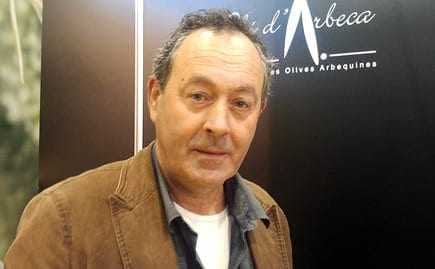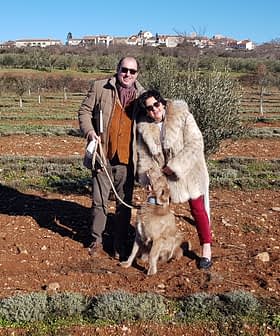
Joan Gras Mullerat, president of Arbequina i Secció de Crèdit SCCL
Olive cultivation amid a range of vegetation — including almond, apple, pear and pine trees and even some grape vines — helped Oli d’Arbeca win the sweet green fruity prize at this month’s Fira de l’Oli extra virgin olive oil exhibition in Les Borges Blanques, says its producer.
Farmer Joan Gras Mullerat, president of Arbequina i Secció de Crèdit SCCL, the cooperative in the Catalan province of Lleida which makes the oil, said the arbequina variety is particularly influenced by local climate and environment.
“Because cultivation in our zone is very diversified, the olives pick up all these aromas of fruit, almonds and pine trees, and even of wine flavor in some parts with grape vines.”
“For me it’s very difficult but the professionals can detect it,” Gras Mullerat told Olive Oil Times.
Indeed, a French perfume company recently spent time at the coop’s mill capturing “olive essence” from the waste water and was very happy with the aroma obtained, he said.
Word of mouth marketing
The oil carries the Les Garrigues designation of origin and its main market is fine dining restaurants and specialty shops in Barcelona, but “a large part of our sales comes from word of mouth.”
Locals who move to Barcelona are very proud of the oil and act as ambassadors for it, recommending it to people there. “That’s been very good for us,” Gras Mullerat said.
“The fact that our village, Arbeca, was the birthplace of Arbequina production, also sparks interest.”
“It’s a little bit more expensive than some others but people value its taste and quality,” he said.
Traditional groves
About 95 miles inland from Barcelona, the coop terrain is fairly hilly so terraces are used. Though mainly traditional, there is also a little intensive cultivation.
The rain-fed groves are at an altitude of about 340 – 400m and there are few problems with olive fruit fly but sometimes with fungus, though no treatment was needed this season.
This harvest, which started in November and finished on January 2, yielded about 1.1m kg of olives and about 200,000 liters of EVOO, Gras Mullerat said.
“We have to harvest early to beat cold snaps but the earlier you harvest, the fruitier the oil,” he said.
As is now the norm for quality producers, milling occurs within 24 hours.
Diversified farming
Olive oil provides about 45 percent of the earnings of the about 400 active coop farmers, whose other crops include cereals, almonds, corn and fodder, and for whom finances are generally “tight”.
The coop, which has a total of about 630 members, also has a credit and a supply section. The latter provides fuel for coop members though they have considerably reduced fuel costs by recycling olive stones as fuel for biomass boilers, Gras Mullerat said. The coop hopes to soon also use this biomass for corn drying. Olive tree leaves are sold cheap to farmers as animal feed.
Molí dels Torms and Molí d’Oli Gabriel Alsina i Fills also winners
Two other producers from the province of Lleida were also among the award winners at the Fira de l’Oli.
Organic producer Molí dels Torms won in the fruity bitter green category with Olicatessen, a single estate coupage with arbequina as the base. The company has won a prize at the exhibition every year for the last five years and its international recognition includes listing in Flos Olei and Der Feinschmecker.
The ripe fruity category prize went to Oli de Castelló from Molí d’Oli Gabriel Alsina i Fills, which grows about a dozen different olive varieties, three of them the natives arbequina, verdiell and alforja, and has won various international awards.
Arbequina i Secció de Crèdit also won the prize for best stand design in the exhibition’s olive oil pavilion.








